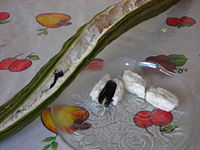
Photo from wikipedia
Arbuscular mycorrhizal fungi (AMF) are worldwide distributed plant symbionts. However, their occurrence in hydrocarbon‐polluted environments is less investigated, although specific communities may be present with possible interest for remediation strategies.… Click to show full abstract
Arbuscular mycorrhizal fungi (AMF) are worldwide distributed plant symbionts. However, their occurrence in hydrocarbon‐polluted environments is less investigated, although specific communities may be present with possible interest for remediation strategies. Here, we investigated the AMF community composition associated with the roots of diverse plant species naturally recolonizing a weathered crude oil pond in the Amazon region of Ecuador. Next generation 454 GS‐Junior sequencing of an 800 bp LSU rRNA gene PCR amplicon was used. PCR amplicons were affiliated to a maximum‐likelihood phylogenetic tree computed from 1.5 kb AMF reference sequences. A high throughput phylogenetic annotation approach, using an evolutionary placement algorithm (EPA) allowed the characterization of sequences to the species level. Fifteen species were detected. Acaulospora species were identified as dominant colonizers, with 73% of relative read abundance, Archaeospora (19.6%) and several genera from the Glomeraceae (Rhizophagus, Glomus macrocarpum‐like, Sclerocystis, Dominikia and Kamienskia) were also detected. Although, a diverse community belonging to Glomeraceae was revealed, they represented <10% of the relative abundance in the Pond. Seventy five % of the species could not be identified, suggesting possible new species associated with roots of plants under highly hydrocarbon‐polluted conditions.
Journal Title: MicrobiologyOpen
Year Published: 2019
Link to full text (if available)
Share on Social Media: Sign Up to like & get
recommendations!